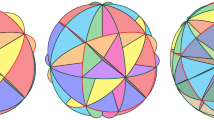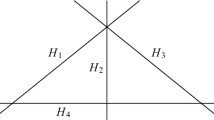Abstract
In this article, we prove in the main theorem that, there is a bijection between the isomorphism classes of a certain type of real hyperplane arrangements on the one hand, and the antipodal pairs of convex cones of an associated discriminantal arrangement on the other hand. The type of hyperplane arrangements considered and the isomorphism classes have been defined precisely. As a consequence, we enumerate such isomorphism classes by computing the characteristic polynomial of the discriminantal arrangement. With a certain restriction, the enumerated value is shown to be independent of the discriminantal arrangement. Later we observe that the restriction we impose on the type of hyperplane arrangements is a mild one and that this conditional restriction is quite generic. Moreover the restriction is defined in terms of a normal system being concurrency free which is a generic condition. We also discuss two examples of normal systems which are not concurrency free in the last section and enumerate the number of isomorphism classes.




Similar content being viewed by others
References
Anil Kumar C P, On very generic discriminantal arrangements, preprint (2020), https://arxiv.org/pdf/2011.05327.pdf
Ardila F, Computing the Tutte polynomial of a hyperplane arrangement, Pac. J. Math. 230(1) (2007) 1–26
Athanasiadis C A, The largest intersection lattice of a discriminantal arrangement, Beiträge zur Algebra und Geometrie, Contrib. Algebra Geom. 40(2) (1999) 283–289
Bayer M and Brandt K, Discriminantal arrangements, fiber polytopes and formality, J. Algebr. Comb. 6(3) (1997) 229–246, https://doi.org/10.1023/A:1008601810383
Buck R C , Partition of space, Am. Math. Mon. 50(9) (1943) 541–544
Carver W B, The polygonal regions into which a plane is divided by n straight lines, Am. Math. Mon. 48(10) (1941) 667–675
Carver W B, Systems of linear inequalities, Ann. Math., Ser. II 23(3) (1922) 212–220
Crapo H H, Concurrence geometries, Adv. Math. 54(3) (1984) 278–301, https://doi.org/10.1016/0001-8708(84)90043-4
Crapo H H, The combinatorial theory of structures, in: Matroid theory (eds) A Recski and L Lovász (Szedeg, 1982) Colloquia Mathematica Societatis János Bolyai, vol. 40, pp. 107–213 (1985) (Amsterdam, North-Holland), https://www.elsevier.com/books/matroid-theory/recski/978-0-444-87580-8
Crapo H H and Rota G C, On the foundations of combinatorial theory: Combinatorial geometries, preliminary edition (1970) (Cambridge, Mass.-London: The M.I.T. Press), pp. iv+289, https://mitpress.mit.edu/books/foundations-combinatorial-theory-preliminary-edition
Dimca A, Hyperplane arrangements: An introduction (2017) (Cham: Universitext, Springer), pp. xii+200, ISBN-13: 978-3-319-56220-9, ISBN-13: 978-3-319-56221-6, https://doi.org/10.1007/978-3-319-56221-6
Falk M, A note on discriminantal arrangements, Proc. Am. Math. Soc. 122(4) (1994) 1221–1227, https://doi.org/10.1090/S0002-9939-1994-1209098-1
Goodman J E, O’Rourke J and Tóth C D, Handbook of discrete and computational geometry, Third Edition of MR1730156, edited by J. E. Goodman, J. O’Rourke and C. D. Tóth, Discrete Mathematics and its Applications (Boca Raton) (2018) (Boca Raton, FL: CRC Press), xxi+1927 pp., ISBN: 978-1-4987-1139-5, https://doi.org/10.1201/9781315119601
Jacobson N, Basic algebra I, Dover Books on Mathematics, Second Edition (2009), ISBN-13: 978-0-486-47189-1, Unabridged republication originally published by W. H. Freeman and Co., San Francisco (1985), xviii+499 pp
Jacobson N, Basic algebra II, Dover Books on Mathematics, Second Edition (2009), ISBN-13: 978-0-486-47187-7, Unabridged republication originally published by W. H. Freeman and Co., San Francisco, 1989, xviii+686 pp
Katz E, Matroid theory for algebraic geometers, in: Nonarchimedean and tropical geometry, Simons Symposium Proceedings (eds) M Baker and S Payne (2016), pp. 435–517 (Cham: Springer), https://doi.org/10.1007/978-3-319-30945-3_12, https://arxiv.org/abs/1409.3503
Koizumi H, Numata Y and Takemura A, On intersection lattices of hyperplane arrangements generated by generic points, Ann. Comb. 16(4) (2012) 789–813, https://doi.org/10.1007/s00026-012-0161-6
Lang S, Algebra, Third Edition, Graduate Texts in Mathematics, Vol. 211 (2002) (New York: Springer-Verlag), xvi+914 pp, ISBN-13: 978-0-387-95385-4, https://doi.org/10.1007/978-1-4613-0041-0, MR1878556
Libgober A and Settepanella S, Strata of discriminantal arrangements, J. Singul.: Spec. Vol. Honor Life Math. Egbert Brieskorn 18 (2018) 440–454, https://doi.org/10.5427/jsing.2018.18w
Numata Y and Takemura A, On computation of the characteristic polynomials of the discriminantal arrangements and the arrangements generated by generic points, Harmony of Gröbner Bases and the Modern Industrial Society (2012) (Hackensack, New Jersey: World Scientific Publications) pp. 228–25, https://doi.org/10.1142/9789814383462_0014
Orlik P and Terao H, Arrangements of hyperplanes, Grundlehren der Mathematischen Wissenschaften (Fundamental Principles of Mathematical Sciences), Vol. 300 (1992) (Berlin: Springer-Verlag) pp. xviii+325, ISBN-13: 978-3-540-55259-6, https://doi.org/10.1007/978-3-662-02772-1
Stanley R, Enumerative combinatorics volume 1, Second edition, Series: Cambridge Studies in Advanced Mathematics, 49 (2011) (Cambridge: Cambridge University Press), pp. xiv+626, ISBN-13: 978-1-107-60262-5, https://doi.org/10.1017/CBO9781139058520
Yu I M and Schechtman V V, Arrangements of hyperplanes, higher braid groups and higher Bruhat orders, Algebraic number theory—in honor of K. Iwasawa (eds) J Coates, R Greenberg, B Mazur and I Satake (1989) (Tokyo: Mathematical Society of Japan) pp. 289–308, Advanced Studies in Pure Mathematics, Vol. 17 (1989) (Boston, MA: Academic Press), https://projecteuclid.org/euclid.aspm/1529259076, https://doi.org/10.2969/aspm/01710289
Zaslavsky T, Counting the faces of cut-up spaces, Bull. Am. Math. Soc. 81(5) (1975) 916–918
Zaslavsky T, Facing up to arrangements: Face-count formulas for partitions of space by hyperplanes, Memoirs of the American Mathematical Society, Vol. 1 (1975), Issue 1, No. 154, pp. vii+102, ISBN-13: 978-0-8218-1854-1, https://doi.org/10.1090/memo/0154
Acknowledgements
The author is grateful to the referee for making useful suggestions which enhanced the writing style of the article. The author is supported by a research Grant and facilities provided by Center for study of Science, Technology and Policy (CSTEP), Bengaluru, India for this research work.
Author information
Authors and Affiliations
Corresponding author
Additional information
Communicated by Arbind Kumar Lal.
The author is supported by a research Grant and facilities provided by Center for study of Science, Technology and Policy (CSTEP), Bengaluru, INDIA for this research work.
Rights and permissions
About this article
Cite this article
Anil Kumar, C.P. On the enumeration of a certain type of hyperplane arrangements. Proc Math Sci 131, 35 (2021). https://doi.org/10.1007/s12044-021-00618-7
Received:
Revised:
Accepted:
Published:
DOI: https://doi.org/10.1007/s12044-021-00618-7




